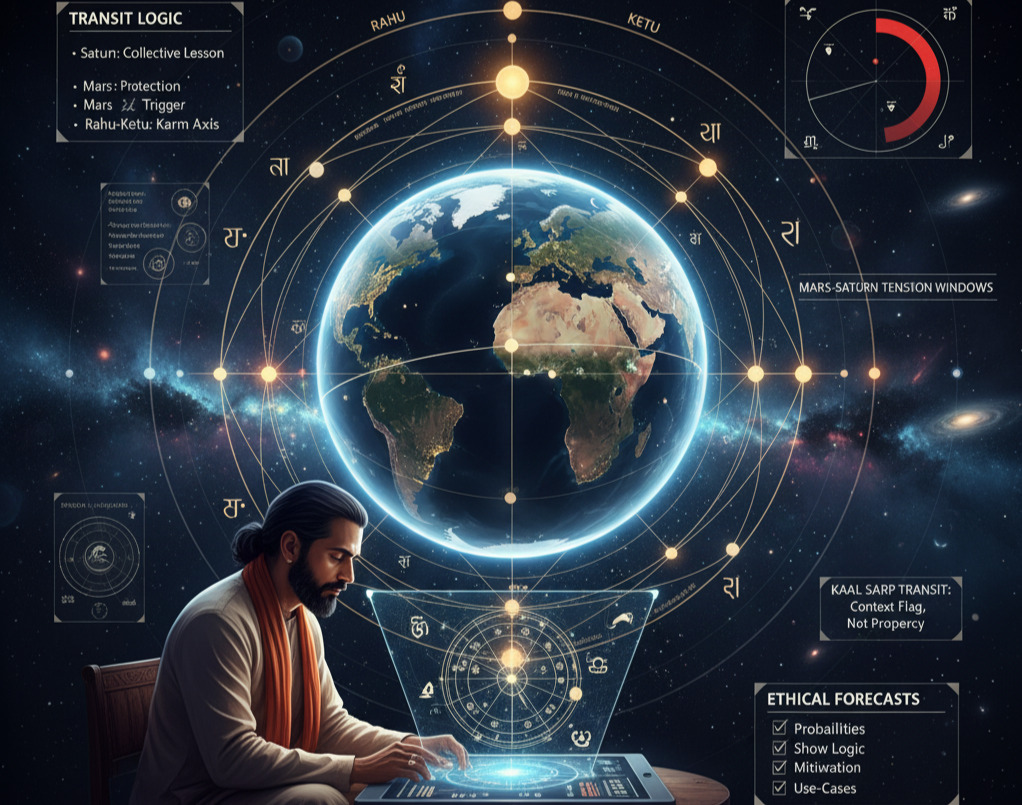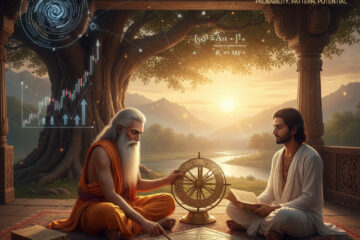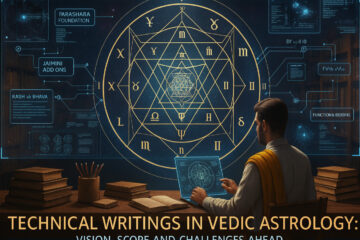Students reach this question eventually: if Jyotish can tell me about my marriage and career, can it also tell us about wars, pandemics, stock crashes or natural disasters? In other words, can we read global events in Vedic astrology the way we read individual karma? The honest answer is: partly yes, partly no.
Vedic astrology was built first for the individual — for kings, for lineages, for personal destiny. That’s where we have an exact birth time, and that’s why dashas work so beautifully. But for the whole planet, or for “humanity,” we don’t have a single birth chart. So when it comes to global events in Vedic astrology, we must lean on transits and mundane logic rather than personal dashas.
This article will show you what is realistic, what is hype, and how to talk about world-level patterns without fearmongering — the Much Needed Astro way.
Why “Global Events in Vedic Astrology” Is a Different Question
In natal work, we start from a fixed point: your lagna and your time of birth. That gives us a reference for Vimshottari dasha, for gochara (transits) over that chart, for Navamsa and divisional nuance. But the moment we ask about global events in Vedic astrology, the first pillar collapses — the reference chart is missing.
That’s why we can’t just say, “In Rahu–Mars dasha the world will have an earthquake.” Whose dasha? Which chart? Instead, the only thing everyone on Earth shares is the sky of right now. So for macro questions we work almost entirely with transits, ingress patterns, nodal shifts, and sometimes national charts when they’re reliable.
How to Read Global Events in Vedic Astrology with Transits
When dashas can’t be applied universally, transits become the common currency. This is the core of Vedic mundane astrology techniques — studying the motion of slow planets (Saturn, Jupiter), nodes (Rahu–Ketu), and hot triggers (Mars) to see when the collective field is more tense or more protected.
Here is a practical way to do it:
- Saturn: sets the collective lesson. In Aquarius or Capricorn it pushes systems, governments, masses. Wherever Saturn sits, that sign/house theme in national charts gets tested.
- Jupiter: is the protection. When Jupiter is strong or in a friendly sign, shocks are cushioned.
- Rahu–Ketu: show the karmic axis of that period — where obsession, polarity, or sudden events can show up.
- Mars: is the matchstick. Wherever Mars transits — especially in hard aspect to Saturn or the nodes — we watch for flare-ups.
So, instead of “X will happen on Y date,” we say: “The next 6–8 weeks show an elevated signature for conflict, accidents, or geo-political muscle-flexing because Mars is confronting Saturn and the nodes.” That is how we frame global events in Vedic astrology.
Mars–Saturn Global Tension Windows
Again and again, history shows: when Mars and Saturn conjoin or oppose — especially in fixed or fiery signs — the world feels heavier. This is classic Mars–Saturn global tension: Mars wants to act, Saturn says no. On the collective level, that looks like:
- border incidents or military posturing
- strikes, protests, or people vs. system standoffs
- infrastructure accidents, fires, or collapses
- sometimes, stress on earth/water systems when other indicators agree
Mars is fast (roughly 45 days in a sign, sometimes much longer with retrograde), Saturn is slow (2.5 years per sign). So when a fast malefic keeps hitting a slow malefic, tension lasts. That’s the kind of pattern we can legitimately flag as a danger window for transits for collective prediction.
What About Kaal Sarp Transit Meaning?
You’ll often see people online saying, “All planets are between Rahu and Ketu — big disaster incoming.” Let’s calm that down. Transit Kaal Sarp-like patterns happen fairly often. If we predicted doom every time, we’d be wrong most of the year.
A better reading of Kaal Sarp transit meaning is:
- It can show collective polarisation — people taking harder positions.
- If slow malefics are also strained (Saturn combust, Mars debilitated or hemmed), the polarisation can become unrest.
- If Jupiter or Venus is strong in the same period, the same polarisation can pass without catastrophe.
So: transiting Kaal Sarp is a context flag, not a prophecy.
Limits of Global Prediction in Jyotish
This is where we have to be explicit. Global events in Vedic astrology can be read as higher probability zones, not as “city X will have an earthquake on day Y.” That level of exactness is not what Jyotish was built for. Earthquakes depend on geology. Market crashes depend on human sentiment, policy, tech, and geopolitics. Astrology mirrors the time-quality in which those things become more likely.
Also: dashas are personal. A dasha without a chart is a car without an engine. That’s why we don’t use personal-style dasha prediction for the whole world. We use transits, eclipses, ingress of slow planets, and, when available, well-timed national charts (independence charts, constitution charts) to narrow the lens.
Ethical Astrology for Public Forecasts
Because “big-event” content travels fast, astrologers must practice ethical astrology for public forecasts. That means:
- Speak in probabilities: “This quarter is volatile,” not “disaster will strike.”
- Show your logic: “Mars is opposing Saturn while nodes change signs.”
- Mention mitigation: “Jupiter in strength can soften this.”
- Give use-cases: “Plan conservatively, avoid aggression, check infrastructure/health.”
Fearmongering ruins credibility. Teaching people to read cycles builds it.
Important Notes
Can Vedic astrology predict natural disasters or wars exactly?
Not exactly. It can show tension windows — Mars–Saturn, eclipse on sensitive degrees, nodal shifts — in which conflicts or disasters are more likely. But naming the exact event, city, and casualty count is outside normal Jyotish scope.
Why can’t we use dashas for the whole world?
Dashas require a single, accurate birth time. Humanity doesn’t have one. For countries with good charts, we can combine dashas with transits and get closer — but that’s then a national prediction, not a planetary one.
Do frequent Kaal Sarp transits mean frequent disasters?
No. Frequency lowers severity. Treat it as a sign of collective tension that must be read together with slow malefics and the strength of benefics.
Is it responsible to post “big disaster” predictions on social media?
Only if you’ve done multi-layer analysis and you frame it as probability, not inevitability. Sensationalism is not Jyotish.
FAQ
Can astrology be combined with data science for world forecasts?
Yes. Transit-based timing plus market/social/geo data can highlight repeating rhythms. Astrology will still be symbolic — it won’t replace seismology or economics — but it adds a powerful time dimension.
Do transits really affect the collective psyche?
Collective behaviour often matches transits: Mars–Saturn = frustration, Jupiter–Venus = optimism, Saturn–Rahu = anxiety/polarity. Vedic philosophy calls this macro–micro resonance.
Why do astrologers disagree on global events?
Because mundane astrology has fewer fixed reference points. Different astrologers prioritise different charts, different eclipses, different historical cycles — so their conclusions differ. Treat all such forecasts as hypotheses.
If precision is limited, what’s the use?
Same use as a weather forecast: to prepare. If you know a high-tension quarter is coming, you de-risk decisions, build buffers, and avoid provocation. That’s already huge value.
Keep Learning with Much Needed Astro
If this way of thinking — technical, honest, non-alarmist — works for you, stay close to Much Needed Astro. We teach Jyotish the way it was meant to be used: timing, context, and compassion. No fluff, no doom.
If you’re serious about studying real Jyotish, stay with Much Needed Astro — no fear-mongering, just clarity you can actually use.



